

Login to my account
Enter your e-mail and password:
New customer? Create your account
Lost password? Recover password
Recover password
Enter your email:
Remembered your password? Back to login
Your cart is empty
Joel White Boat Plans
14 products
Showing 1 - 14 of 14 products
Joel White (1930-1997) was a naval architect (MIT), and designer of some of the most popular designs we carry. No doubt, thousands upon thousands of his designs have been built.
It's quite fair to say that WoodenBoat and the community, were immeasurably enhanced by Joel.
Click WB 141 for a piece on Joel, written by Jon Wilson. And... if you look at the images from that issue, you'll see the three page piece on Joel.

Recently viewed
Our Store is in Brooklin, Maine
at 84 Great Cove Drive. We're open Mon-Fri 8am to 4:30 pm Call 1.800.273.7447. WE'RE RIGHT HERE .
Timely Shipping
We are 99-3/4% sure... that we will ship your order within 24 hours Granted, that does not include weekends and holidays.
Secure payments
Rest assured... not only is our site secure, we do not hold your credit card/payment info.
- Opens in a new window.

- Sort Designs
- Site Upgrades
- Alajuela 33
- Alajuela 38
- Anastasia 32
- Andromeda 48
- Baba 40 Pilothouse
- Birdwatcher II
- CatFisher 28
- Cheoy Lee 43 MS
- Cheoy Lee 53
- Colin Archer Finnish Pilot Boat
- Corbin 39 CC
- Crealock 34
- Crealock 37
- Crealock 44
- CT-44 Pilothouse
- Dartsailor 27
- Dartsailor 30
- Dreadnought 32
- Fairey Fisherman 27
- Fales 32 Navigator
- Fales 38 Explorer
- Fantasia 35
- Fast Passage 39
- Finnclipper 34
- Finnsailer 29
- Finnsailer 35
- Fisher 30 MS
- Fisher 34 MS
- Fisher 37 MS
- Flying Dutchman 12
- Gale Force 34
- Hallberg-Rassy 94 Kutter
- Halman Horizon
- Hans Christian 33
- Hans Christian 36
- Hans Christian 38 MKII
- Hans Christian 38T
- Hans Christian 41
- Hans Christian 43
- Hans Christian 48
- Knud Aage Nielsen Snow Star
- Landfall 39
- Lapworth 50
- LM Mermaid 315
- Lord Helmsman
- Lord Nelson 35
- Lord Nelson 41
- Midget 15'
- Minstrel 23
- Montagu Whaler
- Monterey Clipper
- Nauticat 33
- Nauticat 331
- Nimble 25 Arctic
- Nimble Kodiak 24
- Nor'Sea 27
- Nor'Sea 37
- Norselander 53
- North Sea 33
- Offshore 39
- Offshore 43
- Offshore 45
- Pacific Seacraft 25-1
- Pacific Seacraft 34
- Pacific Seacraft 37
- Pacific Seacraft 40
- Pacific Seacraft 44
- Pacific Seacraft Pilothouse 40
- Passagemaker 33
- Passport 42
- Passport 51
- Puget Sound Daysailer
- Quickstep 24
- Redningsskoyte
- Rhodes Design #1600
- Rossiter Pintail
- Roughwater 33
- Sakonnet 23
- Scanyacht 290
- Sea Eagle 31
- Sea Pearl 28
- Seaforth 24
- Searaker 28
- Southern Cross 28
- Southern Cross 31
- Southern Cross 32
- Southern Cross 35
- Southern Cross 39
- Storfidra 25
- Sun Seeker 23
- Tahiti Ketch
- Tashiba 36 Pilothouse
- Tiffany Jane 34
- Traveller 32
- True North 34
- Vagabond 31
- Vagabond 39
- Valiant 40 Pilothouse
- Valiant 42RS
- Vancouver 25
- Vancouver 36
- Vancouver 42
- Victoria 26
- Victoria 30
- Viksund 31 Goldfish MS
- Vineyard Vixen 29
- Vineyard Vixen 34
- Watson 19.5
- Watson 31.5
- Watson 34.5
- Weatherly 32
- Westsail 28
- Westsail 32
- Westsail 42
- Westsail 43
- Willard 30/8T
- Young Sun 35
- Young Sun 43
- Adventurous
- Barca Verde
- Big Adventure
- Bladerunner
- Celestial Melody
- Charity Rose
- De Vrouwe Christina
- Eagles Quest
- Emerald Mistress
- Fascination
- FRANCIS LEE
- Golden Hour
- Imagine 2012
- Kleinkapitalist
- Little Wing
- Loose Cannon
- Magic Dragon
- Maitresse de Mer
- Montagu Whaler 536
- Morning Light
- Mystic Voyager
- Northern Light
- Ramblin Rose
- RS 1 Colin Archer
- RS 6 Nordland
- s/v Veritas
- Sea Anemone
- Sea Biscuit
- Sea Sisters
- Sherri Lynn
- Small Wonder
- Speculation
- Star Chaser
- Three Quarter Time
- Trustworthy
- Wandering Star
- Wave Dancer
- Wind Dancer
- W. Aarnipalo
- Eivind Amble
- Bent Juul Andersen
- Carl Andersson
- Colin Archer
- William Atkin
- Daniel J. Avoures
- Jay R. Benford
- Bruce Bingham
- Phillip Bolger
- Peter Bruun
- Wendell H. Calkins
- Terry Compton
- William Crealock
- Robert Dufour
- Olle Enderlein
- Joe Fennell
- William Garden
- Thomas Gillmer
- Thomas Hale
- Trygve Halvorsen
- John G. Hanna
- Robert B. Harris
- George S. Hawn, Jr.
- L. Francis Herreshoff
- Lyle C. Hess
- Alan F. Hill
- Eva Hollman
- C. Raymond Hunt
- Stan Huntingford
- Harwood Ives
- Ron Johnson
- John Kaiser, Sr.
- Paul R. Kotzebue
- Bill Lapworth
- Arvid Laurin
- Dick Lefeber
- B. Malta-Muller
- Henry Mohrschladt
- Ed Monk, Sr.
- Palle Mortensen
- Knud Aage Nielsen
- Lars Olof Norlin
- Chuck Paine
- Robert Perry
- Angus Primrose
- Knud Reimers
- Philip Rhodes
- Raymond Richards
- Hugh Rossiter
- Stephen Seaton
- Grahame Shannon
- Robert Slater
- Scott Sprague
- Charles Street
- Ron Swanson
- Yves-Marie de Tanton
- David Thomas
- Reuben Trane
- Turun Veneveistramo
- Erling Viksund
- Michael Volmer
- Willem de Vries-Lentsch
- Gordon R. Wyatt
- Share on Facebook
- Tweet Widget
Joel White's Double Enders
- Log in or register to post comments
All Designers
All vessels, all designs.

Select a Designer

Select a Vessel


Search form

And His Beautiful Boats
In a harbor filled with notable classics, Joel’s designs stand out for their steadfast beauty and clarity of purpose. In almost every category, from dinghy through fully tricked-out sailing yacht, each seems to be at home; the right boat for the right place.
In these turbulent times when so much of what we have known appears uncertain, I find myself looking for heroes who have managed to hold firm, no matter what. Joel White (1930-1997) was surely one of these. He was steadfast, focused, and a generous-spirited friend to many. As the son of the writer E.B. White, he was also something of a cultural hybrid in downeast Maine, especially in his early years, when a man with a degree from M.I.T. in naval architecture doing blue-collar boatbuilding work was an anomaly.
Joel started on his way when he was nine years old and his parents up-staked from Manhattan and moved to a farm in North Brooklin. He roamed the fields and woodlands and explored the beginnings of a saltwater life along the shore of Allen Cove and then farther out into Blue Hill Bay.
Joel kept busy. One spring he raised a baby crow, pretty much a full-time job. One winter he built a little scow with his father and rowed it on their pasture pond come spring. He went lobstering with the fisherman from down the road, caught flounder from a rowboat in the cove, worked in his dad’s wood shop, and learned to sail, mostly on his own, in a Herreshoff 12½ when he was 16. Over the stages of his young life, he came to understand exactly who he was, what he wanted to do, and where he wanted to do it—to be a boatbuilder in Brooklin, Maine. It was upon this ledge that he constructed a life.
Years later when my wife Caroline and I sailed with him aboard his Augie Nielson-designed Danish-built double-ended cutter, Northern Crown , he taught us the art of cruising: simple food, a dinghy that is fun to row and sail, good books and good chowders, and an anchor that stays where you put it, and much more.
Whether we were joined by his daughter, Martha White, or future son-in-law Taylor Allen, or maritime historian and boatbuilder Maynard Bray and his wife Anne, all agreed that by mid-summer we wanted to sail east to the remotest sections of Maine, New Brunswick, and Nova Scotia. To anchor off wild islands and scramble up their windswept heights. To seek out colonies of razorbills, guillemots, puffins, terns, and petrels. To spend time on Grand Manan Island, where fishermen still tended weirs in the old way.
We also wanted to sail among as many wooden boats as possible. In those days, Beals Island-built lobsterboats were everywhere along the Maine coast. Farther east, high-bowed Novi boats dominated. Anchored at night off a reach or thorofare, we would regularly awaken to hear herring seiners and sardiners pounding by on their way to canneries in Stonington, Rockland, Prospect Harbor, or Blacks Harbour in New Brunswick.
In those days, if you went far enough east, you could occasionally see men hauling traps out of peapods or hand-lining for cod. Salt fish was everywhere, hanging to dry from clotheslines out back, nailed to the fish house wall for a quick snack, or stacked on docks by the pallet-load ready for shipment to the Caribbean. In something close to 20 summer cruises, the economics and skills of along-shore fisheries in all their ancient particulars never lost their fascination for Joel.
Back home at the boatyard, as demand for his designs grew, the boats Joel drew and built reflected the linear simplicity and structural integrity of the workboats and yachts we’d sailed among. That these elements appeared in his designs was no accident. By that time, they were hardwired into his consciousness.
Some years later, in the regular column he wrote for WoodenBoat magazine he observed, “Just as a painting is influenced by the artist’s environment and early training, so is the naval architect’s design affected by the area in which he lives and the local traditions of boatbuilding.” In a subsequent column, he described his theory that the best yacht designers instill some of their character traits into their designs.
As examples, he cited Nat Herreshoff, “work-a-holic, a demon for speed, (who) turned out a huge body of work, meticulously designed and crafted, fast and long lived;” Nat’s son, L. Francis, a lover of beauty and simplicity whose yachts were beautiful and simple; and John Alden, a racer and deep-water sailor who “took the fisherman-type schooner and modified the design into offshore yachts that were simple, strong, and economically appealing to the yachtsmen of the Depression years.”
And so it was to be with Joel, his work flowing from the total immersion he lived so deeply along the coast.
When it came right down to it, however, Joel would never talk about himself this way. He was too self-effacing for that. Sure, he might analyze the work of others and draw some conclusions, but he was never the type to spend time staring into his own oeuvre . If someone asked about his designs, hoping to come up with some over-arching summary statement, he’d most likely dismiss the question with one of those self-deprecating chuckles he specialized in, saying something like, “Mostly my designs just walked through the door with customers and then I tried to do the best I could for what they wanted.”
Because he would let his designs speak for themselves, let’s look at a few favorites.
One of these is surely the Bridges Point 24. Joel always said it was harder to design a good-looking small boat than it was a large one. Accordingly, when called upon to design a small sloop for local boatbuilder Wade Dow, he went all the way back to the well-loved Herreshoff 12½, his first command as a boy, for inspiration.
The result was a handsome and versatile sloop, just right for the Maine coast. Quick around the buoys, sturdy in a two-foot chop, small enough to singlehand yet big enough for overnights, the Bridges Point is on almost any sailor’s list as their “next boat.”
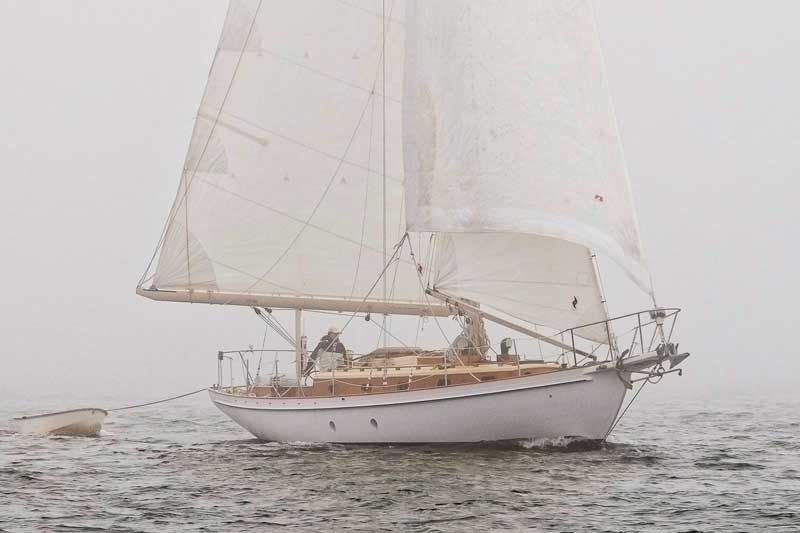
Another favorite is the 43' sloop, Sweet Olive . Built for a repeat customer who deeply valued the time Joel took to develop his ideas for a boat, the result reflected all White had learned to value in a cruising sailboat capable of offshore passages.
Right next to my mooring is the ketch-rigged Center Harbor 31, Grace. Strongly influenced by L. Francis Herreshoff’s masterpiece, Quiet Tune , she sails the waters of the Eggemoggin Reach with her own special blend of simple elegance.
Last on the list is the lobsteryacht Woody , called Lady Jean when it was launched. Transforming a classic lobsterboat design into a successful pleasure boat is no easy task, but Joel managed it perfectly here: forthright, purposeful, but gracefully stretched-out enough to make it beautiful. Even lobstermen nod approvingly when Woody chugs by.
Sometimes sailing through the harbor, I just see Joel’s boats. But often as a particular model comes into view, I hear his voice as well. Joel spoke of boat design and the uses of boats vividly and with particular astuteness. That I can hear his words so clearly still, nearly 20 years after his passing, is beyond describing.
Bill Mayher lives in Brooklin, Maine, and is one of the founders of the maritime web site offcenterharbor.com .
Related Articles

Share this article:

Digital Edition Available ×
Can't get to the store to buy your magazine? We deliver the stories of Maine's coast right to your inbox. Sign up here for a digital edition .
2023 Maine Boat & Home Show ×

Join Us for the Maine Boat & Home Show !
Art, Artisans, Food, Fun & Boats, Boats, Boats
August 11 - 13, 2023 | On the waterfront, Rockland, Maine
Click here to pre-order your tickets.
Show is produced by Maine Boats, Homes & Harbors magazine.
- Share full article
Advertisement
Supported by
Joel White, 66, Designer of Wooden Boats
By Richard Goldstein
- Dec. 10, 1997
Joel White, a naval architect and boat builder who was considered to be one of the country's foremost designers of wooden boats, died Friday at his home in Brooklin, Me. He was 66.
The cause was lung cancer, his son Steven said.
Working out of his Brooklin Boat Yard just south of Acadia National Park for the last four decades, Mr. White created dinghies, sailboats, power boats and yachts with a unifying design theme -- simplicity.
''In a world gone crazy for gadgets and goo-gaws on boats, he preserved a sense of elegance and purity,'' said John Wilson, the editor in chief of WoodenBoat magazine, to which Mr. White contributed designs. ''His was the world of traditional wooden boats and yachts. And he was not interested in self-aggrandizement. He was not seeking monuments to himself. His boats were adorned with nothing unnecessary.''
Mr. White's best-known small boat was the Nutshell Pram, just under eight feet long, which could be sailed, rowed or used as a tender for a larger boat to carry people and supplies from shore. The boat could be sold as a kit with cut-out plywood parts.
He also designed the Haven 12 1/2, a 15-foot-long wooden sailboat known for its stability and its deftness in shallow waters, and the Bridges Point 24, a 24-foot-long fiberglass sailboat.
His most recent design, a 76-foot racing sailboat that is to be launched early next summer -- with perhaps a dozen to be built eventually -- is in the 1920's style, with a long overhang and low freeboard. ''This boat is the pinnacle of his designs,'' said Maynard Bray, a marine engineer and friend.
Steven White said his father ''had very strong feelings on the esthetics of a boat.''
''But he did not believe in boats as furniture,'' the son said. ''He said that if a boat was scratched, that was part of using it. He was interested in form and how a boat performed.''
''There's a certain amount of dewy-eyed enthusiasm about wood that gets a little sticky sometimes,'' Joel White once said. ''People can get so caught up in the Zen of the thing, they sometimes forget what a boat is really for.''
Mr. White was born in Mount Vernon, N.Y., the son of the essayist and author E. B. White and his wife, Katharine, who was fiction editor of The New Yorker. The family moved to a farm in North Brooklin, Me., in the mid-1930's, and the son became immersed in a lifelong love of sailing Maine's coastal waters. He built a 19-foot boat named Martha, in honor of his daughter, that his father sailed after adding his own touch -- carved dolphins, four on each side of the bow, decorated in gold.
One of E. B. White's most enduring essays, ''Once More to the Lake,'' written in 1941, tells of a trip with his son back to the freshwater lake where the father spent vacations as a boy.
Mr. White attended Cornell University and Massachusetts Institute of Technology, from which he obtained a bachelor's degree in naval architecture in 1953. After working on boat building in Newport News, Va., and serving in the Army, he returned to Maine and assumed ownership of the Brooklin boating facility in 1960. His son Steven has been owner and president of the boatyard since 1986.
He was the author of ''Wood, Water & Light: Classic Wooden Boats'' (Norton, 1988) with photographs by Benjamin Mendlowitz. Reviewing the book for The New York Times, Christopher Lehmann-Haupt called it a ''lovely work'' that was ''untainted by snobbery.'' Mr. White read from his father's essays, poems and short stories in a recent audio cassette, ''White on White.''
The editor and writer Roger Angell, Mr. White's half-brother, said that ''he really was a Down Easter. He was reserved in his emotions and instinctively modest.''
Mr. Angell said that Mr. White had resisted corporate offers for his boat business because he did not want to lose control over his creations.
''He said, 'I don't want to make any boats I don't have my hands on.' ''
In addition to his son Steven and Mr. Angell, Mr. White is survived by his wife, Allene; a son, John, of Brooklin; a daughter, Martha Allen-White of Rockport, Me., and six grandchildren.
Classic Sailboat Shop
Specializing in the sale of small classic day sailers and weekenders.

Bridges Point 24 – 1998 Joel White Design, Wade Dow Built
Bridges Point 24 (See Photos Below)
NAME: Bear TYPE: Bridges Point 24 YEAR: 1998
BUILDER: Wade Dow, Bridges Point Boat Yard DESIGNER: Joel White
COMMENTS: The Bridges Point 24 design has been a very popular weekender/daysailer. She is a wonderful example of Joel White’s designs built by Maine Boat builder Wade Dow. New Awlgrip Finish 2006, Complete exterior varnish and wood finish August 2013, Toe rails removed, stripped, refinished & re-bedded August 2013. Diesel flushed & winterized, oil and filter changed, & fuel storage treated November 2013.
DISPLACEMENT: 3,944 lbs BALLAST: 2,100 lbs
LOA: 24’ 0” BEAM: 7’ 9”
LWL:18’ 8” DRAFT: 3’ 5”
SAIL AREA : 278 SQ. FT JIB: 130% Genoa
ENGINE: Yanmar GM 10 Diesel, 9HP FUEL: 6 Gallons
CONSTRUCTION: Hand laid molded fiberglass deck and cabin, green hull, internal lead ballast, solid fiberglass rudder and structural girders. ‘Metalmast’ spars are painted Oyster white aluminum with internal rope halyards, Mast is keel stepped, aluminum boom painted Oyster white, forward cabin V Berth with cushions (Beige) and shelves, Lewmar opening hatch and screen forward for ventilation, Companion-way screen for additional ventilation. Four bronze port lights, Awlgrip white boot top, varnished teak exterior trim, all bronze deck hardware includes 8” bronze bow cleat, two bronze bow chocks, two bronze stern cleats and chocks. Cockpit has fiberglass contoured seats. Small galley to port has stainless steel sink and cooler. Marine portable toilet at foot of V-berth. Teak varnished drop boards. Located in Northampton, Massachusetts. Should you wish to visit and look over this exceptional boat, feel free to call 413-335-6402or e-mail [email protected]
SAILS AND RIGGING:
mainsail (178 sq ft) Mainsail cover
jib 130% furling with UV Cover
roller furling
Two bronze #16 self-tailing sheet winches
Two bronze # 6 winches – one for Jib halyard and one for main halyard
Internal rope halyards, Stainless steel stays and chromed turnbuckles
Harken blocks and traveler Back stay adjuster, Boom vang
STEERING: Varnished tiller steering
ELECTRONICS/ELECTRICAL:
Standard Horizon Explorer VHF with mic, 1- 12 V Battery, Navigation lights
EQUIPMENT: Wind vane, Bulkhead mount compass, Porta-potti, Whale bilge pump, V-Berth cushions, mainsail cover, Braided dock lines, Anchor, Chain and Rhode

Located in Northampton, Massachusetts. Should you wish to inspect the boat see “BEAR” feel free to call 413-335-6402 or e-mail [email protected]
Share this:

- Already have a WordPress.com account? Log in now.
- Subscribe Subscribed
- Copy shortlink
- Report this content
- View post in Reader
- Manage subscriptions
- Collapse this bar

Article Tag: Joel White
I grew up spending my summers in Falmouth, Massachusetts, on Cape Cod. My family has a Joel White–designed Bridges Point 24 sloop; my dad loves to sail and passed his passion down to me. I have been taking sailing lessons since I was eight and I’m now working my fifth summer as a sailing instructor. So, when it came to doing a required “capstone” project for my senior year of high school, sailing was at the forefront of my thinking. I spent months trying to create a project weaving my love for the water with the school assignment. Most students do research and write up a report or try to learn a new skill for their project, but I wanted to do something big.
When I talked to my dad about building a boat, he got super-excited and immediately went to a bookshelf, pulling out Eric Dow’s How to Build the Shellback Dinghy . From that point on, I was determined to build a boat and have it on the water by the end of my senior year.
The Shellback is well behaved under oars. Neither the plans nor the book Building the Shellback Dinghy indicate a brace for the rower’s feet at the ’midship rowing station, but the addition of one would allow for a more powerful pull.
The Shellback is a 11′2″ sailing and rowing dinghy designed by Joel White. The kit I purchased from The WoodenBoat Store came with six sheets of plans, the lumber and precut plywood required to build the boat, all the hardware it would need, the ’midship frame, and the strongback. The plans include lines and offsets and full-sized templates for the three molds, laminated ’midship frame, inner stem, and transom. For a builder working from plans, measured drawings are provided for the 1/4″ plywood planks and the 1/2″ plywood bottom; lofting and spiling aren’t required. Going into this project I had very little woodworking experience and no boatbuilding experience, but I was lucky to have the guidance in Dow’s book as well as the advice of several people in town who had built Shellbacks.
The bottom is obstructed only by the mast step, the daggerboard trunk, and a single laminated frame, leaving the rest of the area clear for the boat’s occupants.
Included in the kit for the sailing Shellback are the blanks for the daggerboard, rudder, and spars. The wooden CNC-cut strongback was easy to assemble and fit together precisely; I made some wooden sawhorses to set it on. Building from the kit went quite smoothly though some steps, while beveling the planks took me a lot of time. Dow’s book was an invaluable resource when I needed additional information on some of the more complex elements of the construction, like cutting the gains at the ends of the planks with a rabbet plane. The actual shaping of the rudder and daggerboard plus making a spar gauge and shaping of the spars are left up to the builder.
The plans call for a straight leech on the 56-sq-ft lugsail. The battens on this Shellback’s sail allow for some roach in the leech and a little more sail area.
I built the dinghy in my family’s two-car garage. Dow’s book includes a list of tools needed for the job—all are common hand tools plus an electric drill. There is a list of “optional tools that will make the job go more quickly.” While the bandsaw and power planer would indeed speed the work, I preferred using hand tools for tasks such as shaping the spars because they are much more forgiving and gave me more control.
The precut sections of the bottom and planks need to have scarfs cut before being joined with epoxy. Set on the strongback and temporarily held with drywall screws, the edges of the bottom get beveled to meet the garboard, then epoxied, using drywall screws at the laps; the middle planks and sheer planks follow in the same manner. I followed the plans carefully when lining up the planks. The molds came with indexing points on them to help with the process.
When the hull was finished, I coated it with epoxy. I knew that I would be launching this boat from the beach, so I ’glassed the bottom to protect it from all the wear of beaching. These steps are not indicated in the plans or the kit, but I wanted the added layers of protection.
The kit comes with long strips of wood for the outwales, inwales, and blocking for the inwales. Assembling the gunwale parts was just one step where it was extremely helpful to have the book How to Build the Shellback Dinghy , as its illustrations, tips, and tricks made the process a lot easier. The outwales go on first to give the hull some rigidity. This step was easier with two people and about 15 clamps to hold each outwale to the hull. They bend easily enough and do not need to be steamed. Silicon-bronze screws and epoxy hold everything in place.
The thwarts were surprisingly hard to get right and the step I had the most trouble with. I used a compass and a bevel to try and get them to sit flush with the hull. I went through about three sets of seats before I had made ones that fit right. I recommend cutting and fitting some scrap wood to get a flush result before using the wood that comes in the kit. The rest of the inside of the hull is fairly easy to assemble. The daggerboard and rudder foils need to be shaped a little bit, and the daggerboard trunk is simple to build by paying close attention to the plans. Make sure to measure a lot when lining everything up. Dry-fit everything where it should go before permanently attaching anything.
I started the Shellback the summer after my junior year, worked most weekends, school breaks, and many evenings, and finished at the end of my senior year. The build process can be wonderful even for a novice woodworker like me. It’s not a simple process, but it is extremely rewarding.
One of the best features of the Shellback is how straightforward it is to transport and launch. My family has a full-sized pickup truck with a 6′ bed, so I don’t need a trailer. Since the dinghy weighs only around 100 lbs, two people can lift it into the truck bed before it is secured with straps for the drive down to the beach. The rig can be easily set up on the beach. I launch from a small beach where the wind is usually blowing straight onshore, so I row out into open water before raising the sail. If the wind were to come from a better angle, I would sail off the beach.
T he Shellback is a joy to sail. I can settle down quite nicely just aft of the middle thwart with my feet braced against the leeward side. Sitting on the bottom of the boat, I have good visibility all around, even under the boom. Because the Shellback is so light, it takes almost no wind to get it moving. I feel like I’m gliding along the top of the water, and when the boat really gets going, I hear the sounds of the water rushing past the bottom of the hull—fantastic! The dinghy tracks very well and is responsive to any tiller movement. Sailing is best in about 12 to 15 knots of wind, although the boat can handle more than 15 and still feel under control. The sail has reefpoints, and shortening sail is as simple as re-tying the downhaul and outhaul to set up your reef. The Shellback is also surprisingly stable—you get a nice little heel, but because the boat is so light it’s easy to counterbalance without the need to hike out, especially when you have two people sailing.
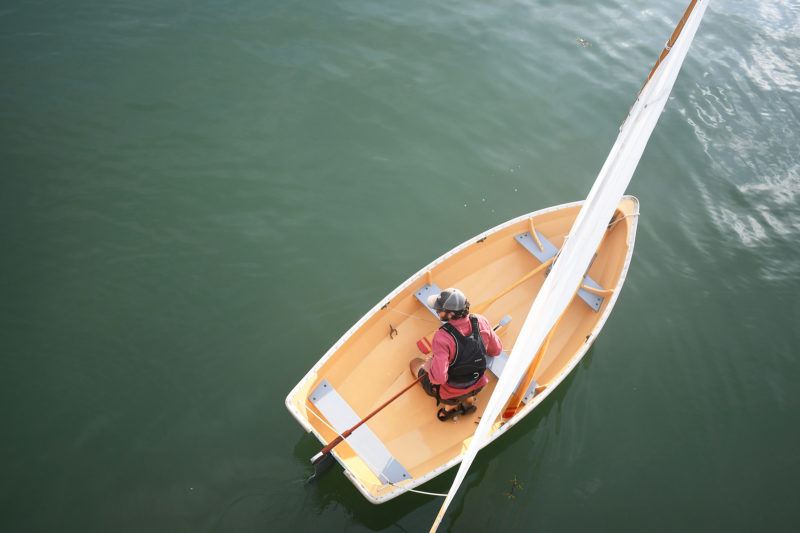
Kneeling on the bottom provides good mobility for sailing.
The hull has reassuring stability so the sailor can confidently shift to leeward to heel the boat and let gravity give the sail a useful shape in light air
That lightness and speed do come with a slight cost—the boat does not carry a lot of momentum. That’s wonderful when you’re going back to a dock or beach because it’s easier to come to a stop, but it loses a lot of speed when tacking. The boat gains that speed back super-fast, but it’s something to take note of. I am 5′6″ so I find ducking under her boom when tacking or jibing quite easy. For me, even though the Shellback slows down on a tack, the light weight is worth it for the easy launching and super-fast acceleration.
T he Shellback rows like a dream. It carries its way in a straight line and moves gracefully through the water. It can easily be rowed solo or with a passenger. Although the plans detail a sculling notch in the transom, I decided not to make one.
The Shellback sits in near proper trim even with a light rower in the bow and a bigger passenger sitting in the stern.
The rudder and daggerboard are designed to stow out of the way when the boat is being rowed. They sit side-by-side in the space created for them between the aft thwart and the transom.
The sculling notch in this Shellback’s transom comes in handy for tootling in confined waterways.
Ben Laster is a first-year student at Worcester Polytechnic Institute studying Robotics. He is an avid boatbuilder, sailing instructor, and fisherman on Cape Cod, Massachusetts.
Shellback Particulars
Length/11′2″ Beam/4′5″ Draft, board up/6.5″ Draft, board down/2′3″ Weight/about 100 lbs Sail area/54 sq ft
The WoodenBoat Store offers the Shellback Dinghy as plans ($75), full-sized precut kits (rowing $2,500, sailing $3,100), and a model kit ($74.95). Eric Dow’s book Building the Shellback Dinghy is also available ($15).
Is there a boat you’d like to know more about? Have you built one that you think other Small Boats Magazine readers would enjoy? Please email us!
Jericho Bay Lobster Skiff LIZZY B
On its inaugural outing, LIZZY B performed up to her builder’s expectations.
B ob Burns, as a novice boatbuilder, once paid a visit to Joel White to get some advice on what boat to build. He had a cedar-strip canoe to his credit, had brought the bare hull of a bass boat to completion, and was ready for a new project. Joel suggested that Catspaw, a 12′ 8″ dinghy he had designed as a carvel-planked version of Capt. Nat Herreshoff’s lapstrake Columbia dinghy, would be well suited for Bob’s growing set of skills. Armed with a set of plans, Bob was soon at work in his cellar. The boat is still there, unfinished, 20 years later.
Before turning his attention to the construction of the interior, Bob filled the space under the cockpit sole with foam pool noodles for flotation. Each noodle provides 30 to 40 pounds of buoyancy.
In 2016, at 72 years old and with retirement from a career in IT management in the offing, Bob was seeing an opportunity to finish the project. That worried his wife, Beth. She imagined the dinghy setting sail from their vacation home on the shore of Lake Mooselookmeguntic, a sprawling wilderness lake in Rangeley Lakes region of western Maine. The lake is subject to sudden storms that can bring high winds and waves over 3′ high. Beth noticed Bob poring over a pair of WoodenBoat articles about the Jericho Bay Lobster skiff , another one of White’s designs. The 15′6″ outboard skiff seemed to be a better choice for the lake—she saw her opportunity and surprised Bob with a set of plans as a Christmas gift the year before his planned retirement.
The 20-hp outboard will drive the skiff at speeds up to 24.5 mph.
Beyond being a better boat for their lakeside summer home, Beth thought building a Jericho skiff, given Bob’s record with the Catspaw dinghy, would keep him busy for at least a couple of years and stave off the ennui that often settles in with retirement. She was wrong on that count. Bob started work on the day after New Year’s last year, and six months later, launched LIZZY B, named after her.
When Bob set up the molds, he stretched the length by 1′ to make more room for a center console. The new length of 16′6″ also would also meet a rule of thumb used by early boatbuilders in the Rangeley Lakes region. They believed that a boat needed to bridge the two troughs between three wave crests. Their assumption that the wave lengths rarely exceeded 8′ set the minimum boat length at 16′. The Jericho skiff’s beam could remain at 62 1/2″ because Bob would have 1/2″ to spare when it came time to move the boat out through the cellar door.
Bob made steady progress on the project this time, even though he worked on the boat only in the mornings and spent his afternoons with Beth so she wouldn’t feel widowed by the boat. On Easter Sunday, he invited his sons and grandsons to the house to take part in moving the boat and the building jig, sporting a new set of wheels for the occasion, out of the cellar. In the back yard, the crew lifted the hull off the strongback, rolled it upright on the lawn, and set it back on the wheeled frame.
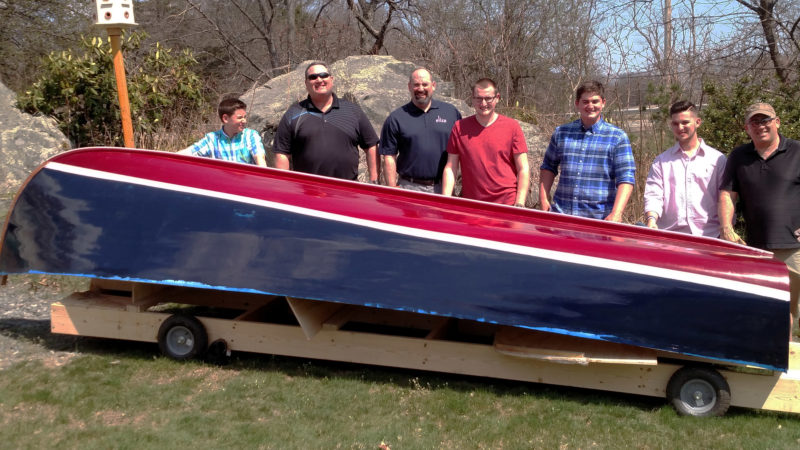
The Burns sons and grandsons gathered for moving the hull out of the cellar on its wheeled building frame.
As they were rolling the boat back into the cellar, a 250-lb boulder tumbled off the stone wall adjacent to the door and hit the side of the hull. It scratched the paint, but the Alaska cedar strips, protected by 24-oz woven biaxial fiberglass on the outside and 12-oz cloth on the inside, took the blow without damage. The unintended test proved the skiff would be able to take a beating on the Maine lakes.
Lake Mooselookmeguntic rests in a bucolic Maine countryside but can get quite rough quite suddenly. When the colors of autumn come to the woods, it’s time for LIZZY B to retreat to the garage.
Have you recently launched a boat? Please email us. We’d like to hear about it and share your story with other Small Boats Monthly readers.
Seen here in the protected waters of Matia Island, IRONBLOOD slips along easily under oar power.
" A fter moving ashore from my first schooner, and having acquired a wife and a small son,” writes Michael Colfer of Bellingham, Washington, “I realized I needed a smaller boat.” He started his search for a boat appropriate to his new life by building a Nutshell pram. It proved too small, so he next built Pete Culler’s Good Little Skiff. Christened SHAMROCK and rigged with a spritsail, it served well for cruising the San Juan Islands and camping ashore on state park campgrounds, but while the skiff did well sailing the protected waters within the archipelago, Michael wanted a boat capable of taking on some more challenging weather in the more exposed areas around the archipelago.
The augmented keel and skeg improve upon the faering’s sailing abilities without obstructing the boat’s interior with a centerboard trunk.
In his search for a more seaworthy beach cruiser capable of carrying more gear, Michael found his way to faerings and variations on the theme by Joel White (16′ Shearwater), Iain Oughtred (14′ 11″ Elf and others), and John Atkins (18′ 7” Valgerda). All three of these designs were inspired by Hardanger faerings of southwest Norway and had similar shapes below the waterline.
Michael built two boats to his design: IRONBLOOD (at the end of the dock) for himself, and a then unnamed faering for his son. The plan was for the two to sail and row the Inside Passage, but family obligations took precedent. After sea trials, the second faering was sold.
Michael bought plans for the Shearwater and although White’s dimensions and drawings make it possible to build without lofting, he lofted the lines and began making some modifications that would make the boat well suited to all Puget Sound waters. He added freeboard throughout and extra height to the ends to provide a dry ride in steep chop. To keep these modifications from increasing the width along the sheerline, he made the sheerstrakes closer to vertical. His changes brought the length to 17′ 3″.
Easily removable thwarts and broad floorboards provide room enough for bedding down at anchor.
He wanted to improve upon the boat’s sailing abilities but didn’t want a centerboard trunk cluttering up the boat’s interior, so his keel is deeper than that of the Shearwater, adding only a little at the bow and increasing the depth to 7″ at the stern for additional lateral resistance. The change was also meant to protect the rudder, making its removal unnecessary when landing on beaches.

IRONBLOOD is quite at home in the San Juan Islands, both in the quiet coves and in the passes that funnel tides and winds.
Michael added storage compartments fore and aft for dry storage of his cruising gear. The aft compartment has a sloped bulkhead to make a comfortable backrest when taking the helm while sitting in the bottom of the boat. The three removable rowing thwarts clear the interior for a night spent aboard at anchor. The floorboards provide a flat, level platform for sleeping.
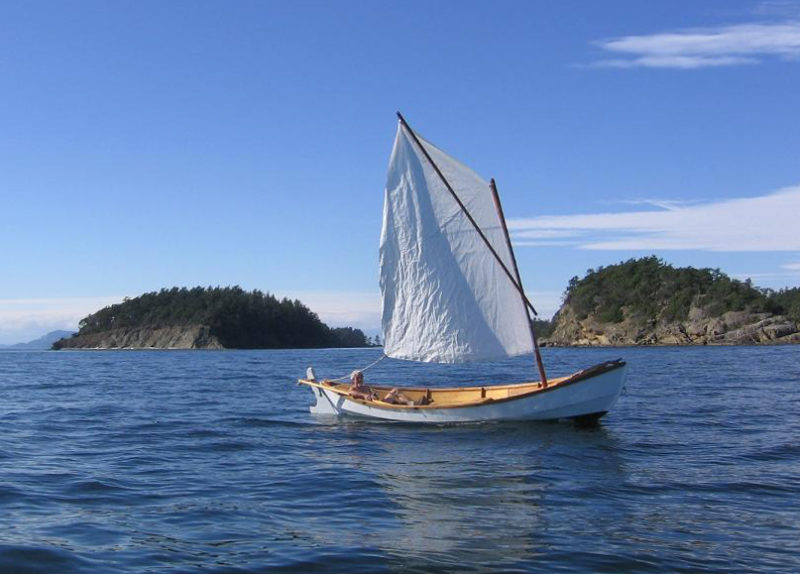
The loose-footed sprit sail makes sailing about as simple as it gets. Light summer breezes make for unhurried passages between islands.
Michael christened his faering IRONBLOOD, drawing upon the meanings of his surname, Colfer: c ol is a Gaelic word for blood, as in blood relative, and f er is the French for iron. IRONBLOOD would be at home in the fjords of Norway, but sails the waters of Puget Sound. She can carry enough gear for a week’s beach camping for two, makes way under oars well, and is stable and smooth under sail, making very little leeway.
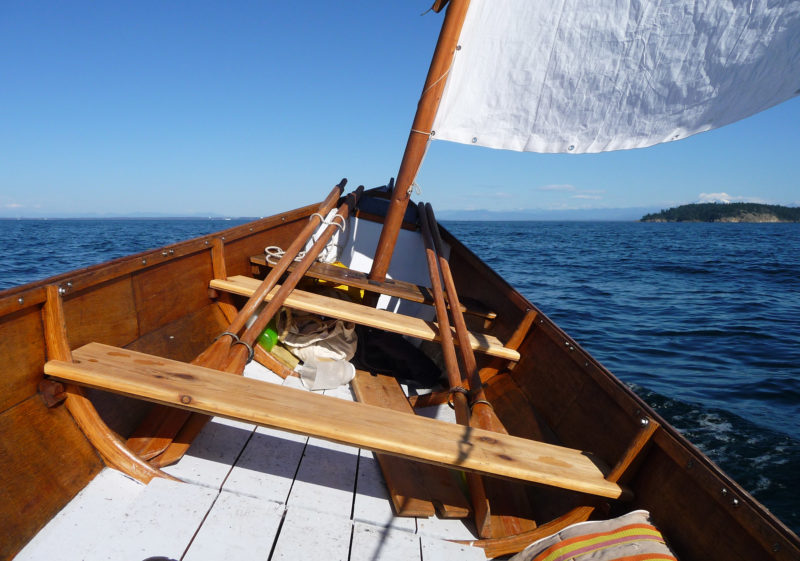
Waters along the northern perimeter of the San Juan archipelago can get quite choppy—winds from the north and northwest have 15 nautical miles of fetch. The higher ends and freeboard keep the going drier. Here IRONWOOD is bound for Matia Island.
Michael says that IRONBLOOD “will run like a scared rabbit for hours at a time given the right conditions.” The increased height at her ends keeps her dry in a chop as he intended.
Subscribe For Full Access
Flipbooks are available to paid subscribers only. Subscribe now or log in for access.
Log in or Sign up
You are using an out of date browser. It may not display this or other websites correctly. You should upgrade or use an alternative browser .
Paint vs. Epoxy Coated hull; Joel White Shearwater
Discussion in ' Wooden Boat Building and Restoration ' started by ironheart , Apr 4, 2009 .
ironheart New Member
An older and very kindly gentleman has GIVEN us Joel White designed Shearwater that he built himself some years ago. Just wanted a home where it would be appreciated. This is a light epoxy and plywood built interpretation of an open Norwegian faering, a traditional pulling boat. He did a nice job of it all the way around with one possible exception. He used correctly used WEST Epoxy for all the joints and laminations - but did not coat the hull inside or out with the epoxy, as I would have been inclined to do. He simply painted the hull in and out with a one part Interlux paint. I have built cold molded and glassed hulls that have lasted going on 20 years - but every surface was covered with the epoxy. We live on the Intracoastal in South Florida and the boat is used regularly (rows beautifully!) but of necessity will be kept outside all year, usually flipped upside down on the dock. She'll occasionally take a few inches of rain in her bilges out on our trot line in the canal during weekends. How well can I expect the paint alone to protect the hull even if the paint is maintained or the boat covered in this climate? (I'm a former Connecticut Yankee so my perspective is skewed.) What is the prognosis for this lovely boat holding up long term outdoors? I'm wondering if my only choice is to strip the paint down and try to epoxy coat it the way it should have been done originally. The stripped hull might not absorb epoxy the way it would have on raw wood originally. Thanks for your input.
PAR Yacht Designer/Builder
Keep the paint in good repair, don't let sweet water collect in her, keep her clean and she'll do just fine. Epoxy as the adhesive is a good choice considering it's physical properties. The wood doesn't have to be embalmed with goo, though it can have profound effects on longevity if done properly. It's not how much epoxy that soaks into the wood that's important. It's the quality of the coating, it's water proofness and intactness that determine how well it will protect the wood. Most paints aren't especially waterproof, particularly compared to epoxy, but that's okay, so long as the coating is uniform and keeping UV off the wood. Repair dings and other damage promptly and you'll have a long life from this little boat.
mydauphin Senior Member
Like PAR said quality of Epoxy matters. Also cleanliness and moisture content of wood. Typical wood in bilge has oils and is reallly wet if you epoxy over it, it won't hold. Clean and dry boat, then use High quality epoxy, with reinforcement in stress areas. It should last forever.
mydauphin: This is not a new boat under construction. I take your comments to mean that I should consider removing the paint in select areas and apply epoxy and reinforcements as needed thereafter. It is conceivable that I could strip the inner bilges and epoxy up to the first garboards before repainting. That might address most sitting rainwater issues. Drying the boat is no problem and oil is not a problem as this is a motorless pulling boat. Just keeping up with the paint as PAR suggests would obviously be the easiest route but with plenty of paint on the boat I'm already seeing some problems. Leaving entire laminated ribs without an epoxy coating may have a price. The central rib has split at a laminated glue line at half it's thickness for about 20 inches from the gunnel down. Going to be interesting trying to get more epoxy into the split to repair it. Figure to drag it in with a thin cloth tape. Thanks for all you input on this, my first post.
- Advertisement:
Unless you can encapsulate the pieces you're putting epoxy on, you're not really protecting anything. The wood will still permit moisture gain/lose cycling which will sheer the coating or let rot find a nice protected place to live, under a plastic umbrella. Some damage, repairs and upkeep are normal things for wooden structures. If you have the option of removing a piece, then you can use proper epoxying techniques to further protect the part. Just slathering around some epoxy in the bilge, will increase the potential of rot, not decrease it.
Some basic inside hull epoxy painting questions
hull paint/epoxy? for river scow
Ground shoe before or after paint
Paint Vs Varnish (Wooden Hull)
1986 26’ clipper craft wood hull paint
Paint over urethane
Plywood boat paint
Removing paint from wooden boat
Brown/bluish spots on freshly painted boat
- No, create an account now.
- Yes, my password is:
- Forgot your password?

Design by Dave Gerr Commentary by Joel White
The design for Summer Kyle first came to my notice in the form of a press release from Gerr Marine. While I tend to digest press releases with a considerable sprinkling of salt, anything from the board of Dave Gerr interests me, and Summer Kyle proved to be no exception. Designs from his office are usually no-nonsense, good-looking boats, with a considerable leaning toward traditional styling. A glance at the outboard profile of this design would seem to confirm this assessment.
Yet there is much about this boat that is not usual or traditional — once the outer veneer of the 1930s styling is peeled away. Most noticeable are her hull shape and her shallow draft; these two elements are integrally related to each other.
Quoting the press release: "Summer Kyle was designed for a client who wanted extreme shoal draft, economical operation at moderate speed, and relatively long range on a vessel he and his wife could live on for several months at a time — 'long exploring vacations.' He specifically requested 1920s to 1930s styling."
In order to achieve very shoal draft in a single-screw powerboat, Gerr has used a hull form derived from the old Sea Bright skiffs of the New Jersey coast — a narrow flat bottom, horizontal chines starting about Station 4 and running to the stern, and a tunnel stern (which Gerr credits to naval architect William Atkin). The tunnel, starting about amidships, is an inverted V-shape, with the box deadwood separating it into two tunnels from Station 6 to Station 9. From Station 9 to the transom, the tunnel is a single inverted V, with straight sections running from the submerged chines to the centerline of the transom above the designed waterline. The perspective lines sketch shows the shape clearly.
With the boat floating at rest on its designed waterline, about one-third of the 22-inch-diameter propeller is above water while the remainder is submerged. The shaft is horizontal, as the flat bottom construction allows the engine to be mounted low in the boat.
There is much that appeals about this tunnel configuration; the shoal draft will permit exploration of many places that are off-limits to deeper craft. Gerr states, "You can run at full cruising speed anywhere there's 24 inches of water or more — a simply incredible, almost unbelievable thing!" If I were running at 14 knots in 24 inches of water, I believe my heart would be in my throat the whole time for fear I might suddenly arrive at a place with only 18 inches of water!
The flat bottom is to be plated with '/-inch copper-nickel plate, and the boat can be grounded out without fear of her falling over, another appealing trait. The propeller and rudder are well protected from damage by the box deadwood and skeg that support the bottom of the rudder.
I do have some concerns about this tunnel. A naval architect friend who has done dozens of designs with tunnel sterns tells me there are two definite no-no's in tunnel design: First, the top of the back end of the tunnel must be completely below water when the boat is at rest; otherwise, when the engine is put into reverse, the propeller will fill the tunnel with air bubbles and the boat will not back down. The second concern is that the rudder when turned must not close off the tunnel,
Particulars, Summer Kyle LOA 41'6" LWL 39'2" Beam 11'6" Draft V7" Displ 15,960 lbs Power 170-hp Yanmar Cruising speed 12 to 14 knots Top speed_16 knots_

Summer Kyle s lineage can be traced through William Atkins tunnel-sterned designs back to the Sea Bright skiffs of the New jersey shore.

LXX A Tunnel-SternedMotor Cruiser as there needs to be plenty of room for the slipstream from the prop to escape. Summer Kyle's design seems to violate the first rule. In talking to Gerr about this, he told me that Atkin had a number of boats built with this tunnel arrangement, some of which are still in service.
My friend also tells me that if there is too much hook downward in the after end of the tunnel, the boat will run bow-down and consequently be very wet. I can't judge if this will be a problem with Summer Kyle.
The arrangement plan is nicely set up for extended cruising for two, with the possibility of two more guests. The owner's cabin aft is large and pleasant, with a big double bunk, a dresser, and a good seat next to the bunk. However, the only head is forward, making it a bit of a trip from the after stateroom.
Amidships, the pilothouse floor is raised over the engineroom. There is plenty of seating, a large chart table to starboard, and a wet locker. In addition to regular floor hatches over the engine, the entire pilothouse floor is designed to be removed for complete access to the machinery below.
Down two steps from the forward cabin, the pilothouse contains the galley to port and a dinette with table opposite to starboard. This can convert to a double berth. The head is to port, with a shower and a hanging locker to starboard. Having a shower separated from the head is fine luxury on a small cruising boat. I have never liked entering a head compartment that appeared to have recently contained a lawn sprinkler, and which had the atmosphere of a tropical rain forest. Right forward, there is a space that can be used either as a workshop or for V-berths on each side. If extended cruising with two couples were contemplated, this would be the second stateroom. The head and shower doors are arranged to close off the forward space for privacy. Altogether, this is a conventional but excellent arrangement for a boat of this size.
Because of the space taken by the tunnel configuration and the steering gear mechanism, there is no cockpit where one can sit outside to enjoy fresh air and the sunset. Gerr has done his best to overcome this problem by making the pilothouse as airy as possible. Virtually all windows open, there is a sliding hatch cover over each side door, and there are larger sliding hatch covers over the steering and navigation stations. In addition, the after deck over the lazarette is big enough for a couple of folding deck chairs. Still, I would miss not having a cockpit.
The machinery specified includes a 170-horsepower Yanmar diesel, with 350 gallons of fuel tankage, giving about a 700-mile range at cruising speed, according to Gerr. Also specified are large battery banks, an inverter and converter, a hot water heater, an air conditioner, an 8-kilowatt generator, and an Espar hot-water cabin heater. With all this equipment properly installed and running, the crew should not suffer for lack of creature comforts.
Construction is to be strip-planked wood, glued with epoxy, and the outer surface sheathed with fiberglass laid in epoxy. This is a cost-effective way to build a boat of this size and should facilitate building the unusual shapes of the tunnel stern. While not specified, I imagine that decks and superstructure will be wood framed, plywood sheathed, and covered with fiberglass and epoxy. Or the decks could be teak veneered for a more yachty appearance.
Summer Kyle is an appealing boat for anyone wanting a medium-sized power cruiser. Her overall appearance is traditional, and I think quite good-looking. Her relatively narrow beam and long hull lines, combined with a single-screw diesel of moderate power, ensure a boat that is economical to operate and maintain. The raised forward deck configuration gives maximum usable space in the accommodations, while the many hatches, portlights, and windows will provide plenty of light and air below. The dinghy can be carried on the after cabintop and easily launched using the mast and boom. The mast will also be useful for carrying steadying sails. Gerr has done a fine job of providing all the necessary elements for fun, and for comfortable cruising.
I am envious of Summer Kyle's future owners. A September departure for a leisurely trip south on the Intracoastal Waterway, taking advantage of the good days to run, and exploring the countryside when the weather threatens, could take them to Florida and across to the Bahamas for a winter spent in tropical climes. The trip back home, following the spring north, might be the best of all.
Plans for Summer Kyle are available from Gerr Marine, Inc., 838 West EndAve., New York, NY 10025.

Continue reading here: Designs by Robert P Beebe and Eldredge Mclnnis Commentary by Joel White
Was this article helpful?
Related Posts
- Design by William Garden Commentary by Maynard Bray
- Nesting Dinghies - Boat Designs
- Designs by Karl Stambaugh and Philip C Bolger Commentary by Mike OBrien
- Two Chesapeake Skiffs - Boat Designs
- Design by Philip C Bolger Commentary by Mike OBrien
- Design by SS Crocker Commentary by Joel White

IMAGES
COMMENTS
Joel White, son of E.B. White, is a legendary Maine wooden yacht builder and designer. Joel put Brooklin Boat Yard on the map as a destination for Maine-made wooden power boats, sailboats, and lobster-inspired boats.
Joel White Boat Plans. Joel White (1930-1997) was a naval architect (MIT), and designer of some of the most popular designs we carry. No doubt, thousands upon thousands of his designs have been built. It's quite fair to say that WoodenBoat and the community, were immeasurably enhanced by Joel. Click WB 141 for a piece on Joel, written by Jon ...
Founded in 1960, Brooklin Boat Yard designs and builds world class wooden boats. We also have an in-house brokerage department selling wooden yachts of all types. ... Founded in 1960 by Joel White, Brooklin Boat Yard combines the longstanding tradition of Maine craftsmanship with modern technology to create world-class yachts that push the ...
Brooklin Boat Yard has maintained an active design office since its inception in 1960. During his lifetime, founder Joel White designed a wide variety of boats, from small dinghies to large cruising and racing yachts, both power and sail. Following Joel, Bob Stephens took over as lead designer at Brooklin Boat Yard.
1930 - 1997. Yacht designer, builder, writer and maritime historian. He was the author of 'Wood, Water & Light: Classic Wooden Boats'. Infomation about the life of White can be found in the the book, 'A Unit of Water, A Unit of Time' by Douglass Whynott. Sailboats Designed By Joel White. Sort by:
Yacht designer Joel White has penned some beautiful canoe stern boats. Learn about Joel White and look over all their double-ender designs. Skip to main content. Menu. Quizzes. Sort Designs ... Joel White's Double Enders. Sakonnet 23. Page created by Jeff on January 19, 2018 - 6:16pm.
Flatfish is Joel White's adaptation of Nathanael G. Herreshoff's century-old Fish-class sloop. The Fish class is a keelboat; the principal modification in the Flatfish is the addition of a centerboard—and the subtraction of some draft. The boat pictured above and on the opposite page was built by Chip Flanagan of Portland, Maine, who's ...
Joel White in his design office. Note that his pencil has no eraser. ... Joel always said it was harder to design a good-looking small boat than it was a large one. Accordingly, when called upon to design a small sloop for local boatbuilder Wade Dow, he went all the way back to the well-loved Herreshoff 12½, his first command as a boy, for ...
Paul Gartside, 10305 W. Saanich Rd., RR #1, Sidney, BC, V8L 3R9, Canada. Plans for Joel White's 23-foot centerboard sloop are available from The WoodenBoat Store, P. O. Box 78, Brooklin, ME 04616; 800-273-7447. Joe/ White's double-ender: refreshingly handsome and the perfect daysailer.
White worked as a boat builder in Newport News, Virginia, served in the Army, then in 1960, in a former herring-packing plant, [3] established Brooklin Boat Yard, where he became known for simple, classic craft from dinghies to yachts, mostly in wood. His Nutshell Pram, under 8 ft long, was sold in plywood kit form. The 15-foot Haven 12½ sailboat has a reputation for stability and for ...
Joel White, naval architect and boat builder who was considered to be one of country's foremost designers of wooden boats, died on Dec 5 at age 66; photo (L)
This 40-foot yacht, the St. Lawrence Yawl, drawn by Canadian Tim Evans, represents an example of a growing trend in wooden boat design. She's a new design based on an old boat — but with changes that allow more modern construction techniques, more efficient rigs, larger accommodations, and faster shapes.
Designs by William Garden Commentary by Joel White. T A 7"illiam Garden has been designing boats for I / \t a long time. Through the years, he has drawn V Y several craft for his own use — the most unusual and interesting of which is Oceanus, designed in 1954. The usual approach to a new design is to pick a length — say, 40 feet overall ...
BUILDER: Wade Dow, Bridges Point Boat Yard DESIGNER: Joel White. COMMENTS: The Bridges Point 24 design has been a very popular weekender/daysailer. She is a wonderful example of Joel White's designs built by Maine Boat builder Wade Dow. New Awlgrip Finish 2006, Complete exterior varnish and wood finish August 2013, Toe rails removed, stripped ...
Joel suggested that Catspaw, a 12′ 8″ dinghy he had designed as a carvel-planked version of Capt. Nat Herreshoff's lapstrake Columbia dinghy, would be well suited for Bob's growing set of skills. Armed with a set of plans, Bob was soon at work in his cellar. The boat is still there, unfinished, 20 years later.
Joel White Designs 10-16-2000, 08:12 AM. I am a great admirer of the work of the late Joel White - the beauty of his designs are just amazing. Can anybody tell me if there exists any kind of design catalogue etc. of his work. I know of the WB plans, the Douglas Whynott book and a few production boats (Bridges Point 24 etc.)- anything else?
Particulars Paris's Lone Star LOD 54'0" LWL 45'0" Beam 13'6". Draft 6'2" Displ 50,000 lbs. Schematic diagrams reveal the different use of interior space aboard Bounty and Lone Star. Herreshoffs Bounty. Bounty carries the classic L. Francis Herreshoff ketch rig. She has less usable space below than Lone Star, but the author believes that ...
A boat created by a designer for his own use is always very interesting and instructive. The designer is dealing with the most demanding client of all — himself — but also the ideal customer from the point of view of similar personal taste and design philosophy, and one with whom communication could hardly be better.
06-06-2023, 12:29 PM. Re: Joel White Flatfish 20'3". It looks like 1 square something, which stands to reason since it is expressing an area. Measure up one of the nearly triangular sections forward (#2 or #4) for approximate area and see if you can back into the units. Rob Hazard.
An older and very kindly gentleman has GIVEN us Joel White designed Shearwater that he built himself some years ago. Just wanted a home where it would be appreciated. This is a light epoxy and plywood built interpretation of an open Norwegian faering, a traditional pulling boat. He did a nice job of it all the way around with one possible ...
The design for Summer Kyle first came to my notice in the form of a press release from Gerr Marine. While I tend to digest press releases with a considerable sprinkling of salt, anything from the board of Dave Gerr interests me, and Summer Kyle proved to be no exception. Designs from his office are usually no-nonsense, good-looking boats, with ...